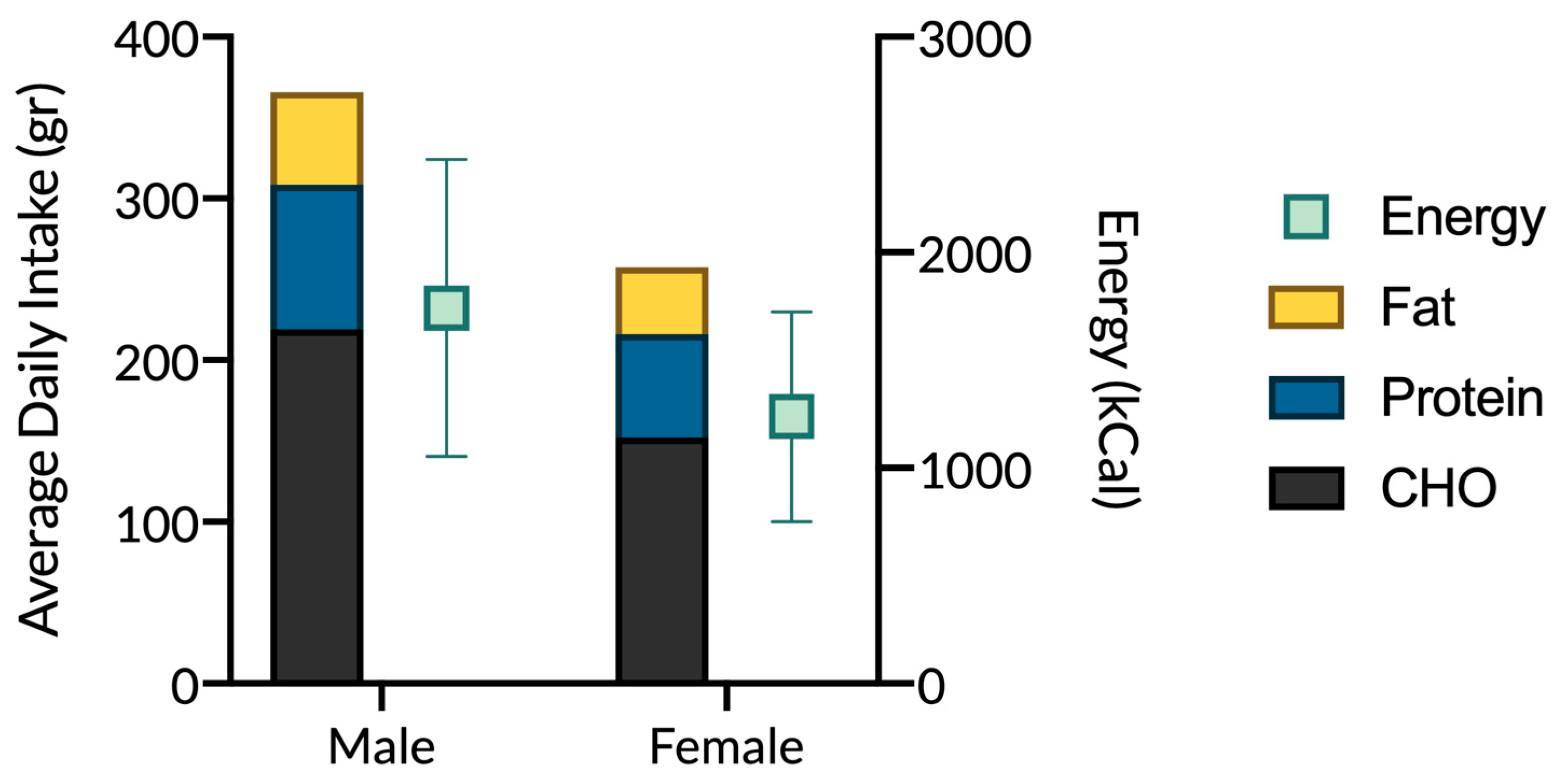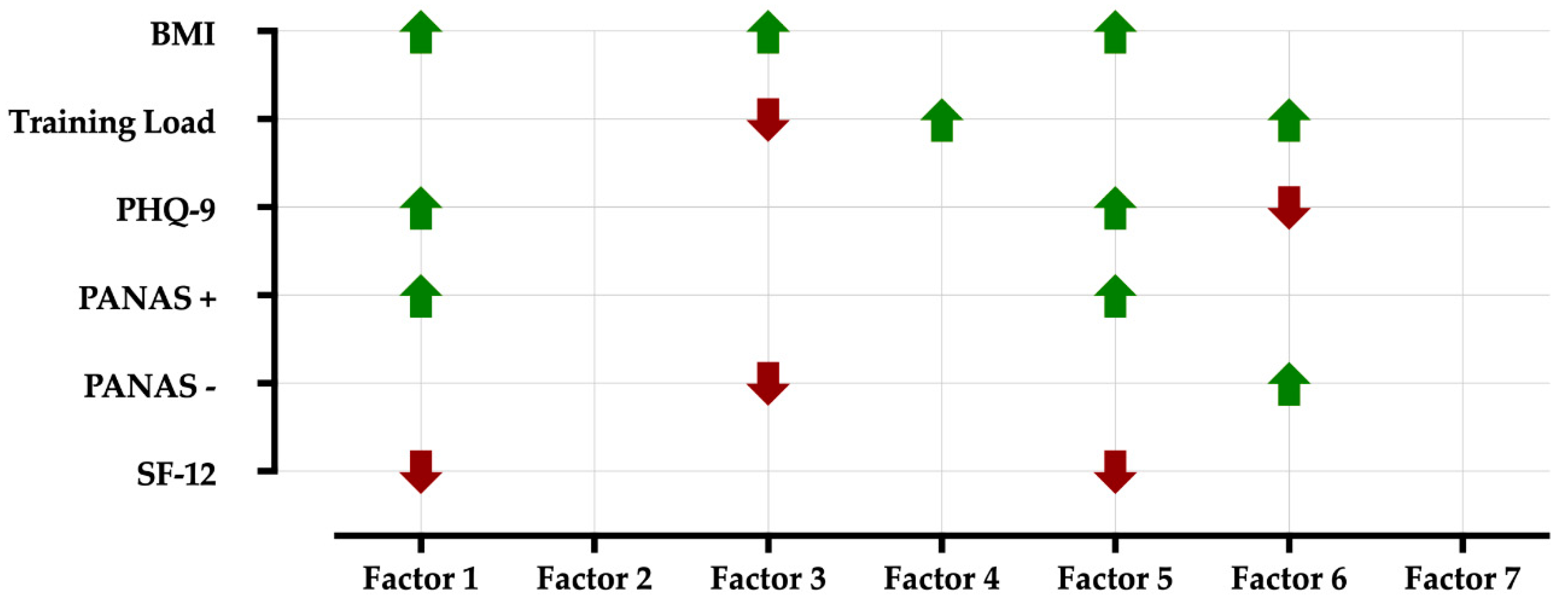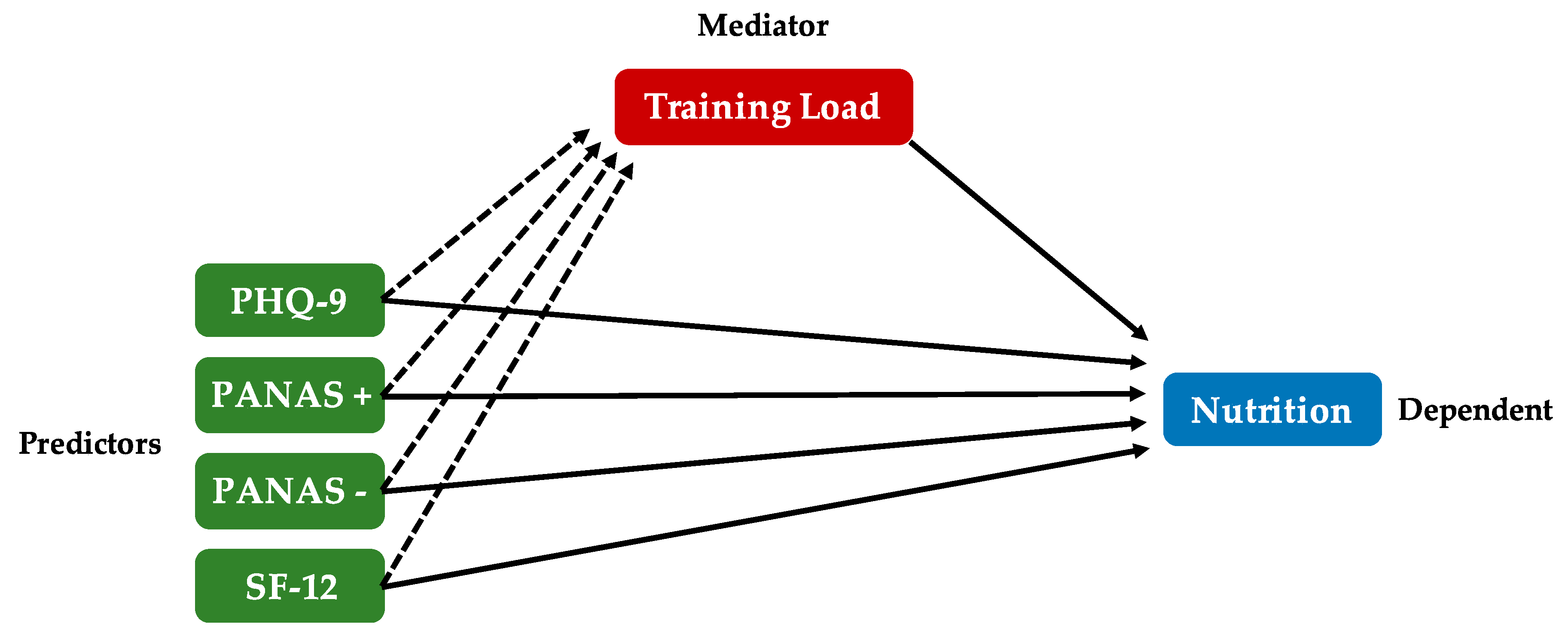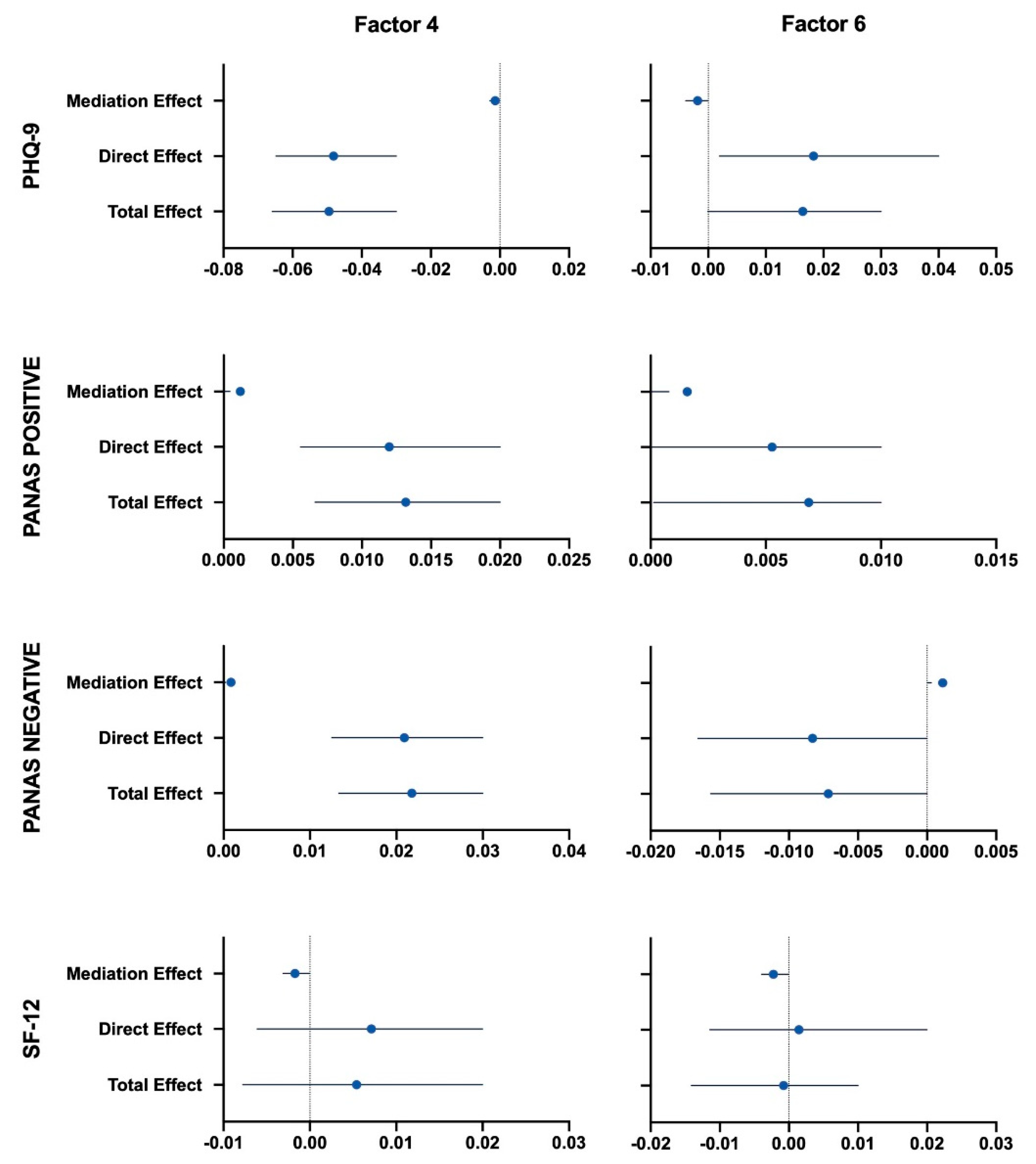Dietary Habits and Psychological States during COVID-19 Home Isolation in Italian College Students: The Role of Physical Exercise
Abstract
1. Introduction
1.1. Mood and Nutrition
1.2. Exercise and Nutrition
1.3. Mood, Exercise and Nutrition
1.4. The COVID-19 Context
2. Materials and Methods
2.1. Participants
2.2. Data Collection
2.3. Dietary Habits
2.4. Physical Exercise
2.5. Psychological Scales
2.5.1. Positive and Negative Affect Schedule (PANAS)
2.5.2. Patient Health Questionnaire 9 (PHQ-9)
2.5.3. 12-Item Short Form Health Survey (SF-12)
2.6. Statistical Analyses
- Average causal mediation effect: it is the indirect effect of the IV (psychological states) on the DV (factors scores) that goes through the mediator (training load).
- Average direct effect: it describes the direct effect of the IV on the DV, without mediator effect.
- Total effect: it stands for the total effect (direct + indirect) of the IV on the DV.
- Proportion Mediated: it describes the proportion of the effect of the IV on the DV that goes through the mediator. It is calculated by dividing the mediation effect through the total effect.
3. Results
3.1. Sample Characteristics
3.2. Dietary Habits
3.3. Factor Analysis
3.4. Physical Exercise
3.5. Psychological States
3.6. Effects of Mood and Exercise on Nutrition
3.7. Mediation Effect
4. Discussion
4.1. Effect of Exercise on Nutrition
4.2. Effect of Mood on Nutrition
4.3. Exercise as a Mediator between Mood and Nutrition
5. Conclusions
Supplementary Materials
Author Contributions
Funding
Conflicts of Interest
References
- Ammar, A.; Trabelsi, K.; Brach, M.; Chtourou, H.; Boukhris, O.; Masmoudi, L.; Bouaziz, B.; Bentlage, E.; How, D.; Ahmed, M.; et al. Effects of home confinement on mental health and lifestyle behaviours during the COVID-19 outbreak: Insight from the ECLB-COVID19 multicenter study. Biol. Sport 2020. [Google Scholar] [CrossRef]
- Di Fronso, S.; Costa, S.; Montesano, C.; Di Gruttola, F.; Ciofi, E.G.; Morgilli, L.; Robazza, C.; Bertollo, M. The effects of COVID-19 pandemic on perceived stress and psychobiosocial states in Italian athletes. Int. J. Sport Exerc. Psychol. 2020. [Google Scholar] [CrossRef]
- Chirico, A.; Lucidi, F.; Galli, F.; Giancamilli, F.; Vitale, J.; Borghi, S.; La Torre, A.; Codella, R. COVID-19 Outbreak and Physical Activity in the Italian Population: A Cross-Sectional Analysis of the Underlying Psychosocial Mechanisms. Front. Psychol. 2020, 11, 2100. [Google Scholar] [CrossRef] [PubMed]
- Owens, M.R.; Brito-Silva, F.; Kirkland, T.; Moore, C.E.; Davis, K.E.; Patterson, M.A.; Miketinas, D.C.; Tucker, W.J. Prevalence and Social Determinants of Food Insecurity among College Students during the COVID-19 Pandemic. Nutrients 2020, 12, 2515. [Google Scholar] [CrossRef] [PubMed]
- Rodgers, R.F.; Lombardo, C.; Cerolini, S.; Franko, D.L.; Omori, M.; Fuller-Tyszkiewicz, M.; Linardon, J.; Courtet, P.; Guillaume, S. The impact of the COVID-19 pandemic on eating disorder risk and symptoms. Int. J. Eat. Disord. 2020, 53, 1166–1170. [Google Scholar] [CrossRef] [PubMed]
- Ammar, A.; Brach, M.; Trabelsi, K.; Chtourou, H.; Boukhris, O.; Masmoudi, L.; Bouaziz, B.; Bentlage, E.; How, D.; Ahmed, M.; et al. Effects of COVID-19 Home Confinement on Eating Behaviour and Physical Activity: Results of the ECLB-COVID19 International Online Survey. Nutrients 2020, 12, 1583. [Google Scholar] [CrossRef] [PubMed]
- Antunes, R.; Frontini, R.; Amaro, N.; Salvador, R.; Matos, R.; Morouco, P.; Rebelo-Goncalves, R. Exploring Lifestyle Habits, Physical Activity, Anxiety and Basic Psychological Needs in a Sample of Portuguese Adults during COVID-19. Int. J. Environ. Res. Public Health 2020, 17, 4360. [Google Scholar] [CrossRef] [PubMed]
- Gallo, L.A.; Gallo, T.F.; Young, S.L.; Moritz, K.M.; Akison, L.K. The Impact of Isolation Measures Due to COVID-19 on Energy Intake and Physical Activity Levels in Australian University Students. Nutrients 2020, 12, 1865. [Google Scholar] [CrossRef]
- Wang, X.; Lei, S.M.; Le, S.; Yang, Y.; Zhang, B.; Yao, W.; Gao, Z.; Cheng, S. Bidirectional Influence of the COVID-19 Pandemic Lockdowns on Health Behaviors and Quality of Life among Chinese Adults. Int. J. Environ. Res. Public Health 2020, 17, 5575. [Google Scholar] [CrossRef]
- Brooks, S.K.; Webster, R.K.; Smith, L.E.; Woodland, L.; Wessely, S.; Greenberg, N.; Rubin, G.J. The psychological impact of quarantine and how to reduce it: Rapid review of the evidence. Lancet 2020, 395, 912–920. [Google Scholar] [CrossRef]
- Arab, A.; Mehrabani, S.; Moradi, S.; Amani, R. The association between diet and mood: A systematic review of current literature. Psychiatry Res. 2019, 271, 428–437. [Google Scholar] [CrossRef] [PubMed]
- Gibson, E.L. Emotional influences on food choice: Sensory, physiological and psychological pathways. Physiol. Behav. 2006, 89, 53–61. [Google Scholar] [CrossRef] [PubMed]
- Firth, J.; Gangwisch, J.E.; Borisini, A.; Wootton, R.E.; Mayer, E.A. Food and mood: How do diet and nutrition affect mental wellbeing? BMJ 2020, 369, m2382. [Google Scholar] [CrossRef] [PubMed]
- Tomiyama, A.J.; Schamarek, I.; Lustig, R.H.; Kirschbaum, C.; Puterman, E.; Havel, P.J.; Epel, E.S. Leptin concentrations in response to acute stress predict subsequent intake of comfort foods. Physiol. Behav. 2012, 107, 34–39. [Google Scholar] [CrossRef]
- Lassale, C.; Batty, G.D.; Baghdadli, A.; Jacka, F.; Sanchez-Villegas, A.; Kivimaki, M.; Akbaraly, T. Healthy dietary indices and risk of depressive outcomes: A systematic review and meta-analysis of observational studies. Mol. Psychiatry 2019, 24, 965–986. [Google Scholar] [CrossRef]
- Liu, X.; Yan, Y.; Li, F.; Zhang, D. Fruit and vegetable consumption and the risk of depression: A meta-analysis. Nutrition 2016, 32, 296–302. [Google Scholar] [CrossRef]
- Gomez-Pinilla, F. Brain foods: The effects of nutrients on brain function. Nat. Rev. Neurosci. 2008, 9, 568–578. [Google Scholar] [CrossRef]
- Pribis, P. Effects of Walnut Consumption on Mood in Young Adults-A Randomized Controlled Trial. Nutrients 2016, 8, 668. [Google Scholar] [CrossRef]
- Geller, K.; Lippke, S.; Nigg, C.R. Future directions of multiple behavior change research. J. Behav. Med. 2017, 40, 194–202. [Google Scholar] [CrossRef]
- Grant, N.; Wardle, J.; Steptoe, A. The relationship between life satisfaction and health behavior: A cross-cultural analysis of young adults. Int. J. Behav. Med. 2009, 16, 259–268. [Google Scholar] [CrossRef]
- Joo, J.; Williamson, S.A.; Vazquez, A.I.; Fernandez, J.R.; Bray, M.S. The influence of 15-week exercise training on dietary patterns among young adults. Int. J. Obes. 2019, 43, 1681–1690. [Google Scholar] [CrossRef] [PubMed]
- Donati Zeppa, S.; Sisti, D.; Amatori, S.; Gervasi, M.; Agostini, D.; Piccoli, G.; Bertuccioli, A.; Rocchi, M.B.L.; Stocchi, V.; Sestili, P. High-intensity Interval Training Promotes the Shift to a Health-Supporting Dietary Pattern in Young Adults. Nutrients 2020, 12, 843. [Google Scholar] [CrossRef] [PubMed]
- Andrade, A.M.; Coutinho, S.R.; Silva, M.N.; Mata, J.; Vieira, P.N.; Minderico, C.S.; Melanson, K.J.; Baptista, F.; Sardinha, L.B.; Teixeira, P.J. The effect of physical activity on weight loss is mediated by eating self-regulation. Patient Educ. Couns. 2010, 79, 320–326. [Google Scholar] [CrossRef] [PubMed]
- Joseph, R.J.; Alonso-Alonso, M.; Bond, D.S.; Pascual-Leone, A.; Blackburn, G.L. The neurocognitive connection between physical activity and eating behaviour. Obes. Rev. 2011, 12, 800–812. [Google Scholar] [CrossRef] [PubMed]
- Annesi, J.J.; Mareno, N. Indirect effects of exercise on emotional eating through psychological predictors of weight loss in women. Appetite 2015, 95, 219–227. [Google Scholar] [CrossRef] [PubMed]
- Annesi, J.J. Supported exercise improves controlled eating and weight through its effects on psychosocial factors: Extending a systematic research program toward treatment development. Perm. J. 2012, 16, 7–18. [Google Scholar] [CrossRef]
- Annesi, J.J.; Mareno, N. Temporal aspects of psychosocial predictors of increased fruit and vegetable intake in adults with severe obesity: Mediation by physical activity. J. Community Health 2014, 39, 454–463. [Google Scholar] [CrossRef]
- Di Renzo, L.; Gualtieri, P.; Pivari, F.; Soldati, L.; Attina, A.; Cinelli, G.; Leggeri, C.; Caparello, G.; Barrea, L.; Scerbo, F.; et al. Eating habits and lifestyle changes during COVID-19 lockdown: An Italian survey. J. Transl. Med. 2020, 18, 229. [Google Scholar] [CrossRef]
- Romero-Blanco, C.; Rodriguez-Almagro, J.; Onieva-Zafra, M.D.; Parra-Fernandez, M.L.; Prado-Laguna, M.D.C.; Hernandez-Martinez, A. Physical Activity and Sedentary Lifestyle in University Students: Changes during Confinement Due to the COVID-19 Pandemic. Int. J. Environ. Res. Public Health 2020, 17, 6567. [Google Scholar] [CrossRef]
- Ingram, J.; Maciejewski, G.; Hand, C.J. Changes in Diet, Sleep, and Physical Activity Are Associated With Differences in Negative Mood During COVID-19 Lockdown. Front. Psychol. 2020, 11, 588604. [Google Scholar] [CrossRef]
- Foster, C.; Florhaug, J.A.; Franklin, J.; Gottschall, L.; Hrovatin, L.A.; Parker, S.; Doleshal, P.; Dodge, C. A new approach to monitoring exercise training. J. Strength Cond. Res. 2001, 15, 109–115. [Google Scholar] [PubMed]
- Haddad, M.; Stylianides, G.; Djaoui, L.; Dellal, A.; Chamari, K. Session-RPE Method for Training Load Monitoring: Validity, Ecological Usefulness, and Influencing Factors. Front. Neurosci. 2017, 11, 612. [Google Scholar] [CrossRef] [PubMed]
- Falk Neto, J.H.; Tibana, R.A.; de Sousa, N.M.F.; Prestes, J.; Voltarelli, F.A.; Kennedy, M.D. Session Rating of Perceived Exertion Is a Superior Method to Monitor Internal Training Loads of Functional Fitness Training Sessions Performed at Different Intensities When Compared to Training Impulse. Front. Physiol. 2020, 11, 919. [Google Scholar] [CrossRef] [PubMed]
- Watson, D.; Clark, L.A.; Tellegen, A. Development and validation of brief measures of positive and negative affect: The PANAS scales. J. Pers. Soc. Psychol. 1988, 54, 1063–1070. [Google Scholar] [CrossRef] [PubMed]
- Kapikiran, N.A. Positive and Negative Affectivity as Mediator and Moderator of the Relationship between Optimism and Life Satisfaction in Turkish University Students. Soc. Indic. Res. 2012, 106, 333–345. [Google Scholar] [CrossRef]
- Terracciano, A.; McCrae, R.R.; Costa, P.T., Jr. Factorial and construct validity of the Italian Positive and Negative Affect Schedule (PANAS). Eur. J. Psychol. Assess. 2003, 19, 131–141. [Google Scholar] [CrossRef]
- Kroenke, K.; Spitzer, R.L.; Williams, J.B. The PHQ-9: Validity of a brief depression severity measure. J. Gen. Intern. Med. 2001, 16, 606–613. [Google Scholar] [CrossRef]
- Spitzer, R.L.; Kroenke, K.; Williams, J.B. Validation and utility of a self-report version of PRIME-MD: The PHQ primary care study. Primary Care Evaluation of Mental Disorders. Patient Health Questionnaire. JAMA 1999, 282, 1737–1744. [Google Scholar] [CrossRef]
- Du, N.; Yu, K.; Ye, Y.; Chen, S. Validity study of Patient Health Questionnaire-9 items for Internet screening in depression among Chinese university students. Asia Pac. Psychiatry 2017, 9. [Google Scholar] [CrossRef]
- Rizzo, R.; Piccinelli, M.; Mazzi, M.A.; Bellantuono, C.; Tansella, M. The Personal Health Questionnaire: A new screening instrument for detection of ICD-10 depressive disorders in primary care. Psychol. Med. 2000, 30, 831–840. [Google Scholar] [CrossRef]
- Ware, J., Jr.; Kosinski, M.; Keller, S.D. A 12-Item Short-Form Health Survey: Construction of scales and preliminary tests of reliability and validity. Med. Care 1996, 34, 220–233. [Google Scholar] [CrossRef] [PubMed]
- Payakachat, N.; Gubbins, P.O.; Ragland, D.; Flowers, S.K.; Stowe, C.D. Factors associated with health-related quality of life of student pharmacists. Am. J. Pharm. Educ. 2014, 78, 7. [Google Scholar] [CrossRef] [PubMed]
- Apolone, G.; Mosconi, P.; Quattrociocchi, L. Questionario Sullo Stato di Salute SF-12. Versione Italiana; Associati, G.E., Ed.; Guerini e Associati: Milan, Italy, 2001. [Google Scholar]
- Taber, K.S. The Use of Cronbach’s Alpha When Developing and Reporting Research Instruments in Science Education. Res. Sci. Educ. 2018, 48, 1273–1296. [Google Scholar] [CrossRef]
- Tingley, D.; Yamamoto, T.; Hirose, K.; Keele, L.; Imai, K. Mediation: R Package for Causal Mediation Analysis. J. Stat. Softw. 2014, 59, 38. [Google Scholar] [CrossRef]
- Tucker, M.; Reicks, M. Exercise as a gateway behavior for healthful eating among older adults: An exploratory study. J. Nutr. Educ. Behav. 2002, 34 (Suppl. S1), S14–S19. [Google Scholar] [CrossRef]
- Jayawardene, W.P.; Torabi, M.R.; Lohrmann, D.K. Exercise in Young Adulthood with Simultaneous and Future Changes in Fruit and Vegetable Intake. J. Am. Coll. Nutr. 2016, 35, 59–67. [Google Scholar] [CrossRef] [PubMed]
- Fleig, L.; Kuper, C.; Lippke, S.; Schwarzer, R.; Wiedemann, A.U. Cross-behavior associations and multiple health behavior change: A longitudinal study on physical activity and fruit and vegetable intake. J. Health Psychol. 2015, 20, 525–534. [Google Scholar] [CrossRef]
- Ferrari, A.J.; Somerville, A.J.; Baxter, A.J.; Norman, R.; Patten, S.B.; Vos, T.; Whiteford, H.A. Global variation in the prevalence and incidence of major depressive disorder: A systematic review of the epidemiological literature. Psychol. Med. 2013, 43, 471–481. [Google Scholar] [CrossRef]
- Salk, R.H.; Hyde, J.S.; Abramson, L.Y. Gender differences in depression in representative national samples: Meta-analyses of diagnoses and symptoms. Psychol. Bull. 2017, 143, 783–822. [Google Scholar] [CrossRef]
- Henssler, J.; Stock, F.; van Bohemen, J.; Walter, H.; Heinz, A.; Brandt, L. Mental health effects of infection containment strategies: Quarantine and isolation-a systematic review and meta-analysis. Eur. Arch. Psychiatry Clin. Neurosci. 2020. [Google Scholar] [CrossRef]
- Hossain, M.M.; Sultana, A.; Purohit, N. Mental health outcomes of quarantine and isolation for infection prevention: A systematic umbrella review of the global evidence. Epidemiol. Health 2020, 42, e2020038. [Google Scholar] [CrossRef] [PubMed]
- Ball, K.; Lee, C. Relationships between psychological stress, coping and disordered eating: A review. Psychol. Health 2000, 14, 1007–1035. [Google Scholar] [CrossRef] [PubMed]
- Ford, P.A.; Jaceldo-Siegl, K.; Lee, J.W.; Youngberg, W.; Tonstad, S. Intake of Mediterranean foods associated with positive affect and low negative affect. J. Psychosom. Res. 2013, 74, 142–148. [Google Scholar] [CrossRef] [PubMed]
- Benton, D. Carbohydrate ingestion, blood glucose and mood. Neurosci. Biobehav. Rev. 2002, 26, 293–308. [Google Scholar] [CrossRef]
- Ventura, T.; Santander, J.; Torres, R.; Contreras, A.M. Neurobiologic basis of craving for carbohydrates. Nutrition 2014, 30, 252–256. [Google Scholar] [CrossRef]
- Wurtman, R.J.; Wurtman, J.J. Carbohydrate craving, obesity and brain serotonin. Appetite 1986, 7, 99–103. [Google Scholar] [CrossRef]
- Molendijk, M.; Molero, P.; Ortuno Sanchez-Pedreno, F.; Van der Does, W.; Angel Martinez-Gonzalez, M. Diet quality and depression risk: A systematic review and dose-response meta-analysis of prospective studies. J. Affect. Disord. 2018, 226, 346–354. [Google Scholar] [CrossRef]
- Tanskanen, A.; Hibbeln, J.R.; Hintikka, J.; Haatainen, K.; Honkalampi, K.; Viinamaki, H. Fish consumption, depression, and suicidality in a general population. Arch. Gen. Psychiatry 2001, 58, 512–513. [Google Scholar] [CrossRef]
- Christensen, L. The effect of food intake on mood. Clin. Nutr. 2001, 20, 161–166. [Google Scholar] [CrossRef]
- Lopez-Olivares, M.; Mohatar-Barba, M.; Fernandez-Gomez, E.; Enrique-Miron, C. Mediterranean Diet and the Emotional Well-Being of Students of the Campus of Melilla (University of Granada). Nutrients 2020, 12, 1826. [Google Scholar] [CrossRef]
- Donati Zeppa, S.; Agostini, D.; Gervasi, M.; Annibalini, G.; Amatori, S.; Ferrini, F.; Sisti, D.; Piccoli, G.; Barbieri, E.; Sestili, P.; et al. Mutual Interactions among Exercise, Sport Supplements and Microbiota. Nutrients 2019, 12, 17. [Google Scholar] [CrossRef] [PubMed]
- Bremner, J.D.; Moazzami, K.; Wittbrodt, M.T.; Nye, J.A.; Lima, B.B.; Gillespie, C.F.; Rapaport, M.H.; Pearce, B.D.; Shah, A.J.; Vaccarino, V. Diet, Stress and Mental Health. Nutrients 2020, 12, 2428. [Google Scholar] [CrossRef] [PubMed]
- MacKinnon, D.P.; Krull, J.L.; Lockwood, C.M. Equivalence of the mediation, confounding and suppression effect. Prev. Sci. 2000, 1, 173–181. [Google Scholar] [CrossRef] [PubMed]
- Kenny, D.A. Mediation. Available online: http://davidakenny.net/cm/mediate.htm (accessed on 2 September 2020).
- Jackson, C.E.; Di Placido, J. Vitality as a Mediator between Diet Quality and Subjective Wellbeing among College Students. J. Happiness Stud. 2020, 21, 1617–1639. [Google Scholar] [CrossRef]






| Factors | |||||||
|---|---|---|---|---|---|---|---|
| Component | 1 | 2 | 3 | 4 | 5 | 6 | 7 |
| Starch | 0.883 | ||||||
| Carbohydrates | 0.832 | ||||||
| Glycaemic load | 0.821 | −0.361 | |||||
| Plant-based protein | 0.751 | 0.373 | |||||
| Glucides | 0.656 | −0.450 | |||||
| Vegetable fats | 0.826 | ||||||
| Omega-6 | 0.747 | 0.362 | |||||
| Monounsaturated fats | 0.738 | 0.526 | |||||
| Polyunsaturated fats | 0.714 | 0.378 | |||||
| Vitamin E | 0.620 | 0.597 | |||||
| Animal lipids | 0.842 | ||||||
| Saturated fats | 0.366 | 0.795 | |||||
| Animal-based protein | 0.659 | 0.483 | 0.378 | ||||
| Protein value | 0.559 | 0.377 | |||||
| Vitamin C | 0.767 | ||||||
| Folic acid | 0.730 | ||||||
| Vitamin A | 0.568 | ||||||
| Vitamin B6 | 0.357 | 0.555 | |||||
| Insoluble fibre | 0.368 | 0.549 | 0.520 | ||||
| Tryptophan | 0.913 | ||||||
| Phenylalanine | 0.903 | ||||||
| Tyrosine | 0.395 | 0.830 | |||||
| Vitamin D | 0.864 | ||||||
| Omega-3 | 0.798 | ||||||
| Vitamin B12 | 0.537 | ||||||
| Glycaemic Index | −0.791 | ||||||
| Soluble fibre | 0.435 | 0.518 | 0.541 | ||||
| Eigenvalues | 8.64 | 3.94 | 2.52 | 1.97 | 1.36 | 1.23 | 1.13 |
| % of cumulative variance | 32.0 | 46.6 | 55.9 | 63.3 | 68.3 | 72.9 | 77.1 |
Publisher’s Note: MDPI stays neutral with regard to jurisdictional claims in published maps and institutional affiliations. |
© 2020 by the authors. Licensee MDPI, Basel, Switzerland. This article is an open access article distributed under the terms and conditions of the Creative Commons Attribution (CC BY) license (http://creativecommons.org/licenses/by/4.0/).
Share and Cite
Amatori, S.; Donati Zeppa, S.; Preti, A.; Gervasi, M.; Gobbi, E.; Ferrini, F.; Rocchi, M.B.L.; Baldari, C.; Perroni, F.; Piccoli, G.; et al. Dietary Habits and Psychological States during COVID-19 Home Isolation in Italian College Students: The Role of Physical Exercise. Nutrients 2020, 12, 3660. https://doi.org/10.3390/nu12123660
Amatori S, Donati Zeppa S, Preti A, Gervasi M, Gobbi E, Ferrini F, Rocchi MBL, Baldari C, Perroni F, Piccoli G, et al. Dietary Habits and Psychological States during COVID-19 Home Isolation in Italian College Students: The Role of Physical Exercise. Nutrients. 2020; 12(12):3660. https://doi.org/10.3390/nu12123660
Chicago/Turabian StyleAmatori, Stefano, Sabrina Donati Zeppa, Antonio Preti, Marco Gervasi, Erica Gobbi, Fabio Ferrini, Marco B. L. Rocchi, Carlo Baldari, Fabrizio Perroni, Giovanni Piccoli, and et al. 2020. "Dietary Habits and Psychological States during COVID-19 Home Isolation in Italian College Students: The Role of Physical Exercise" Nutrients 12, no. 12: 3660. https://doi.org/10.3390/nu12123660
APA StyleAmatori, S., Donati Zeppa, S., Preti, A., Gervasi, M., Gobbi, E., Ferrini, F., Rocchi, M. B. L., Baldari, C., Perroni, F., Piccoli, G., Stocchi, V., Sestili, P., & Sisti, D. (2020). Dietary Habits and Psychological States during COVID-19 Home Isolation in Italian College Students: The Role of Physical Exercise. Nutrients, 12(12), 3660. https://doi.org/10.3390/nu12123660











